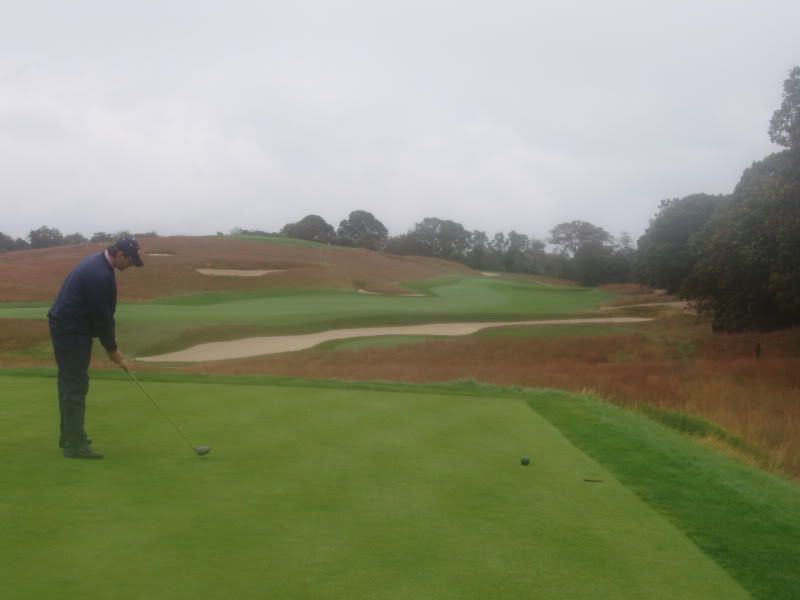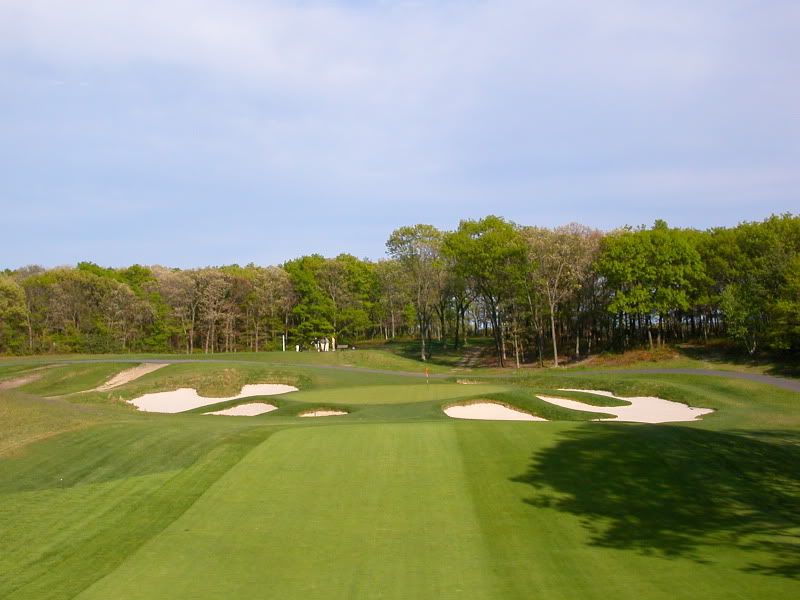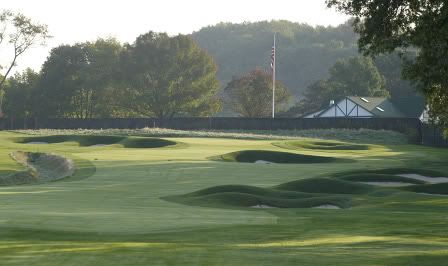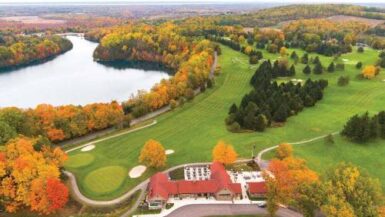
SAN FRANCISCO – There was once a time when the U.S. Open was far more than just “Golf’s Toughest Test.” As far back as the 1970s golf journalists christened the event “The Tricked-up Open” for all the cloak and dagger claustrophobia of criminally narrow fairways, parquet floor greens, and mine fields of unexploded double bogeys. Golfers walked around the course like they were trapped in an Edgar Allen Poe story and the U.S.G.A. seemed to revel in it. They would tell the players to panic, how much to panic, and what form the panic should take, (usually it involved running screaming into the night with arms waving maniacally – basically acting like the narrator at the end of “The Fall of the House of Usher” kind of deal).
But Tom Meeks went overboard once too often. It’s one thing when the scream queen goes up the stairs, opens the door she shouldn’t, and the maniac hacks her into fish food. It’s quite another when the killer then jumps off the screen and starts slashing the movie goers!
Mike Davis has ushered in a…slightly…kinder, gentler U.S.G.A. It’s still golf’s toughest test, it’s just that it’s now golf’s fair toughest test, and while Meeks erred on the side of too tough, Davis has no problem letting the players’ ability shine through. After all – making more birdies means more excitement, and more excitement means patrons get their moneys worth. It’s fun to go to the U.S. Open and cheer lustily once again for great golf shots instead of politely clapping for close calls.
This year, however, there is a bit more disquiet than usual in the Mike Davis era. “It’s like playing the hardest hole you’ve ever played in your life, like 18 straight holes,” said Steve Marino after a practice round, and Architect Bill Love said in an interview that he felt Olympic could come close to rivaling Oakmont, Winged Foot (West) and Oakland Hills (South) for difficulty. Finally, Davis himself said the first six holes would be the toughest start in many years.
Olympic will start with a 520 yard par-4, the longest in major championship history. It will play driver, three-wood. Nuff said.
Although the second hole is only 428 yards, the fairway has been shifted so that golfers must control distance off the tee or roll into perdition due to the fairway’s reverse camber. It proves what 1964 U.S. Open Champion Ken Venturi recently said to be true, “This is a shot maker’s golf course, a thinker’s course. You don’t overpower Olympic, even if you’re long.”
The third is a brutish 247-yard par-3 to a narrow sliver of a green, while the next three par-4s play 438, 498, and 491 respectively. The start is nothing if not relentless.
So it got us to thinking – let’s take a look at some other great opening salvos in the world of competitive golf.
Kiawah Island (Ocean Course) – Since the PGA Championship will be here in two months, here’s what to expect.
The first hole (395 yards) should prove the easiest hole on the course despite having one of the narrowest fairways. The green is at ground level and the bunkering benign compared to later in the round.
Though the S-shaped par-5 second hole is only 557 yards, the diagonal sweep of the salt marsh might tempt players into biting off too much of the hazard and making a costly mistake. The wind will be in the players’ face and the green is elevated, so it’s no pushover and will be difficult to reach in two.
The third (390 yards) is the shortest hole on the course, a hard curving dog-leg left with a tall specimen tree and bunker in the left center of the fairway guard the plateau on the left which is the best place to get a good angle to the elevated green. A new tee sits on an island in the marsh.
At four (458 yards) we finally we get a truly difficult hole with two forced carries over the marsh made tougher still by a prevailing wind likely to be in the players face and three pot bunkers peppering the fairway.
The par-3 fifth hole (217 yards) looks like a Redan with the green set at an oblique diagonal from back left to front right, only the green does not slope away from the player. A large hump in the middle really makes it two small greens in one.
Of course, the wind will be the course’s main defense.
“Everything depends on the wind, but that’s the one thing you can’t depend on, if you get what I mean,” said architect Pete Dye in an interview with your author. “The course changes significantly with the wind direction. You can play one hole into one crosswind one day, the other crosswind the next, and dead into the wind on the day after that….Guys who play well in the wind will have an advantage because it swirls winds here, and changes direction from hour to hour. I hope we get a 15-20 knot wind. That’ll help make the course more difficult.”
Still, get your scoring done early, because from 13 on the course and wind get markedly tougher.
Merion (East) – The site of next year’s U.S. Open will provide a fascinating exploration into golf course architecture and tournament set-up. Merion is remarkably short by today’s standards, and may be comparatively easy when compared to its larger brethren like Oakmont or Oakland Hills. After all, David Graham hit 18 out of 18 greens during his sparkling final round 67 and finished 6-under for the tournament, an excellent tally.
But Tom Fazio and his team have extended it over 600 yards since the 1981 Open. Tom Paul, one of the world’s most renowned experts on golf course architecture and the historian who collaborated on Merion’s course history had some interesting and poignant observations.
“The routing of Merion East is referred to as the “3 sets.” Psychologically, golfers need to hold their score together for the first six holes and not get to high a score so they can take advantage of the next seven holes, 7-13, which are called Merion’s “short stretch,” where you have to get aggressive, but you can really inflate your score up if you fail to execute. The last five holes are really tough, so it’s important to hold things down early and set the tone for the round and keep to the game plan,” he explained.
Part of the game plan is further dictated by a unique quirk to Merion’s routing. It’s par-70 with only two par-5s, but they come at holes two and four and both are traditionally unreachable in two. The second hole will play 585. In 1981 only two people even tried to reach the second hole in two – Paul would know, he marshaled that hole in ’81.
“Perhaps a third of the field might have a go at it with the new advances in equipment,” he surmises. At 600 yards in 1981, four has always been unreachable in two. With an additional 50 yards added for next year, it could stretch to 650 yards.
“Again, it’ll be an interesting question again to see who goes for it in two,” he contends.
As for the rest, the only relief may come at the opener, a benign par-4 under 400 yards where the pros will club down to a hybrid. If they hit driver, they might even put it OB into the road. They’ll have just a wedge or 9-iron for their second.
The third, fifth, and sixth are another story altogether.
“Three was a 185-190 yard reverse Redan, with a deep, steep-faced bunker that now can stretch to 255 yards. Five, a 504 yard par-4, is regarded by everyone as one of the best natural landform holes in the world. A creek runs all along the left and the land all slopes towards creek. Six, which they stretched to 490 yards, had a bit of a Road hole-like drive – you used to have to drive over OB – but not any more, a new tee changes the angle,” Paul concludes.
All in all, it looks like people’s fears that Merion might be too short or too easy may be unfounded, as the course now stretches to over 7,000 yards.

National Golf Links of America – “The opening stretch at National is incredible, absolutely among the best in the entire world,” beamed golf architecture expert Bruce Moulton. “But that’s C.B. Macdonald for you. That’s what he did.”
First Hole (330 Yards, “Valley”) – “People four-putt this green all the time. In fact, I’ll take perverse delight in telling the world that Jay Flemma, one of the best putters I have ever known – a guy who makes 50 footers all the time – four-putted that green from 70 feet for a seven,” boasted a soon to be testicle-less Moulton. When I get back to New York, I’m breaking out my rusty tools. To quote Marcellus Wallace, “I’m gonna get medieval on your…” [expletive deliberately omitted.]
Second hole (330 yards, “Sahara”) – “Modeled after a hole at St. George’s, this hole is short but just as dangerous as its predecessor.”
Third hole (430 yards, “Alps”) – “One of the most thrilling holes in golf. You can hit the biggest drive you can and it still might not do you any good as the approach is blind to a punchbowl green. Go over the green, and good luck finding your ball.”
Fourth Hole (190 yards, “Redan”) – “Most other Redans pale in comparison to the size and scale of this hole. A huge kick-plate to an enormous green that slopes severely away from the player defines the hole, but it dramatically uphill as well, far tougher than the watered down versions, you find at more pedestrian copies.”
“Valley, Sahara, Alps, Redan?” Moulton then asked rhetorically, “That’s Da Vinci, Donatello, Botticelli, and Michelangelo.”
Garden City Golf Club- Joe Saladino won the Travis Invitational at Garden City this year, so he’s an excellent source for discussing the wonderful opening stretch which is filled with half-par holes where you can gain and lose strokes in the blink of an eye.
“The opening five holes at Garden City are really exciting because you can get off to a great start and set the tone for your round, or you can really put yourself behind the 8-ball. You can make birdie or even eagle at the par-4 first hole [302 yards] and at the par-5 fourth hole [523 yards] but at the same time there are some hazardous spots you can find where you can make bogey or double, so you have to make decisions early in the round,” Saladino explained. “Some courses give you time to ease into the round and then you get faced with the risk-reward decisions, but at GCGC you get that right out of the box.”
That’s what makes Garden City great – there’s nothing but swing holes out there. Saladino continued:
“I like four, I think it’s a great par-5,” he said. “If you hit a good tee shot you can have just a 5 or 6-iron into the green and you can make eagle or birdie, but there is trouble off the tee such as bunkers, the OB right, and the false front of the green. You feel like you should make birdie, but you can easily make bogey too.”
Also the par-3 second hole (127 yards) is a gorgeous, but deadly par-3 over a deep chasm to a green surrounded by bunkers, the par-4 third (407 yards) is a great example of a “Bottle Hole” and the par-4 fifth hole (360 yards) is also a possible eagle. In fact, during his march to the 2008 Travis finals, Saladino stunningly went eagle-eagle at four and five before bowing to Ohio’s Mikey Kelley in the final.

Bethpage Black – Okay, so the first hole (par-4, 30 yards) is as boring as a glass of warm milk: a right angle dog-leg with the inside guarded by a stand of trees and the green bracketed by five o’clock and seven o’clock bunkers. (Bleah!) Two through six, however, are arguably the course’s most interesting run. The par-4 second hole (389 yards) curves like a scimitar sharply uphill to a plateau green. The hole requires a draw off the tee or the ball will run through the fairway into the rough or trees.
The par-5 fourth (517 yards) and the par-4 fifth (478 yards) are among the best back-to-back holes in American golf. The visually arresting glacier bunker bisects the fourth fairway, but the tiny green is also defended by both steep slopes that run off into perdition and more deep bunkers.
Golf architecture expert Ran Morrissett of the super-smart site GolfClubAtlas.com said of the fifth hole, “The classic use of a diagonal hazard. The fairway is off set to both the tee and green. The ideal tee shot is a power fade across the waste bunker on the right. From there, a draw will best find the elevated target but the shallow green is adept at allowing only the well hit ball to hold.”
Your author also likes the par-4 sixth hole (402 yards) where a big drive to a plateau reveals a fairway that cascades downhill to a green surrounded by bunkers. Gorgeous, exciting, and demanding, it stands out as a unique golf hole.
Oakland Hills – Despite its reputation as “The Monster,” the course is much more than just narrow fairways and bracketing bunkers Robert Trent Jones introduced to this Donald Ross layout in the 1950s. A cunning, serpentine routing and some of the best greens in America beguile and befuddle the greatest golfers in the world. Brutishly long, but never one dimensional, if they shaved all the rough and let the magnificent fairway contours back into play, it would be even bettr. Each of the first five holes is long, twisting, and cunning, not just the par- fifth where T.C. Chen came to ruin.

Oakmont – Ah, Mighty Oakmont. Perhaps only Winged Foot can match it for its wondrous combination of grandeur and terror. The first hole alone (par-4, 482 yards) has brought many a player to grief. With bunkers bracketing the fairway on both sides, and a ditch separating the first and ninth fairways, it’s a white knuckle first drive of the day. The second shot is blind to a green at the base of a hill, and the green slopes severely from front to back. In an NCAA Championship tournament back in the ’70s, a playoff was needed to determine the individual champion. The first competitor proceeded to slice his tee shot into the trees, seemingly OB, and then launched four more off the course as well. He conceded the match without his opponent hitting a shot. Caddies later found his first ball in bounds.
After crossing the Turnpike, the players face a 440 yard par- again flanked by a ditch on the left and deep bunkers on the right that pinch the fairway. The green is both tilted to the right and severely contoured.
Three and four features the stately, but fearsome Church Pews. At three (par-4, 428 yards) four more bunkers pinch the landing area, while at four (par-5, 609 yards) the players reverse direction and get a rare shot at a birdie since the hole is downhill all the way.




